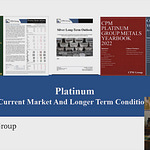Jeffrey Christian, Managing Partner at CPM Group, continues the "Facts and Fictions" series, shedding light on current dynamics in the U.S. dollar and treasury markets, while also providing timely insights into the precious metals markets.
Precious Metals Market Overview
Gold prices experienced a sharp drop to around $3,329.80, down roughly $65 from the previous day, but remain historically high. Despite a temporary dip likely due to profit-taking and uncertain geopolitical factors, CPM Group anticipates gold prices will sustain strong support around $3,200, with potential for further increases based on ongoing economic and political uncertainties.
Silver prices similarly dipped to $35.74 per ounce, falling below the $36 mark for the first time since early June. The July COMEX futures roll, involving approximately 359 million ounces, is expected to provide short-term support and potentially drive prices higher. Post-July, silver could test lower support levels near $32 to $33.
Platinum remains elevated around $1,289 per ounce, buoyed by speculative investment demand and July futures activities. CPM expects platinum prices may temporarily maintain these high levels but eventually correct below $1,200 following the futures contract roll.
Palladium's price, currently near $1,075, has seen moderate gains largely due to speculative interest linked to platinum's rise, but remains restrained by weak fabrication demand.
Clarifying Inflation Expectations
Christian addressed misconceptions about inflation indicators, clarifying that experienced economists like former Federal Reserve Chair Alan Greenspan monitor gold prices to gauge inflation expectations—not actual inflation.
U.S. Dollar Strength and Misconceptions
Contrary to narratives suggesting a flight from the U.S. dollar, the trade-weighted dollar remains robust, down only 6.4% this year but still up significantly from historical lows—42% higher compared to April 2011 lows. Investors globally continue favoring U.S. dollars and treasuries as safe-haven assets amid heightened global uncertainties.
Central Banks and Dollar Holdings
Central banks are not broadly abandoning the dollar; rather, they are moderately diversifying reserves, primarily away from euros and into other currencies and gold. U.S. dollar holdings remain relatively stable around 58%-62% of global foreign exchange reserves, reflecting continued confidence in the currency’s safety and stability.
Reality of U.S. Treasuries Demand
Investor demand for U.S. treasuries remains strong, with foreign holdings surpassing $9 trillion. Despite reductions in Federal Reserve-held treasuries as part of monetary policy normalization, global demand remains resilient, disproving claims of widespread international abandonment.
Interest Rate Context
While interest rates have risen from the historic lows experienced during the COVID pandemic and the subsequent zero-interest-rate environment, current treasury yields align closely with pre-2008 crisis norms, underscoring stable investor sentiment.












Share this post